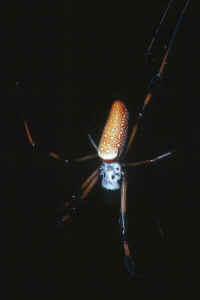
Wild Flowers and Their Associates Photos 041-060
A click on the number of a photo produces an enlargement to 800 by 600 pixels. A click on a photo produces a smaller enlargement.
Photo 041. Nephila clavipes (Comstock, pp. 440-447) from Florida. A very large orb-weaving southern spider whose web is unusually strong. Small birds can become fatally trapped. Because the lowest part of its web is usually at least 7 feet above the ground with long support threads between tall shrubs or trees, it creates an interesting silhouette against a blue sky particularly when the sun is low in the sky. As shown more clearly in the next picture, it has remarkable tufts of hair in patches on its legs.
Photo 042. Nephila calvipes
Photo 043. Nephila calvipes Its strong web when freshly made has the unusual character that the spiral strands make angles with the radial strands that are closer to a right angles than is the case with other orb-weavers. That character is less conspicuous in this old damaged web because it has been only slightly repaired in those areas where the viscid spiral threads are missing or distorted.
Photo 044. Nephila clavipes
Photo 045. Leucauge venusta (Comstock, pp. 436-438) on the underside of a fern leaf.
Photo 046. Leucauge venusta from Silver Springs, Florida
Photo 047. Leucauge venusta from Ocala, Florida.
Photo 048. Leucauge venusta in her web. Her egg sac of unhatched spider eggs hangs above her.
Photo 049. Nephila clavipes (male) in the web of his much larger mate.
Photo 050. Cyclosa conica (Comstock, pp. 465-467) from the woods of my back yard in 1970. This species of spider neatly arranges the exoskeletons of its victims in its web to camouflage its presence hanging downward below them.
Photo 051. Tetragnatha elongata (Comstock, pp. 425-426) from Land-of-Lakes, Florida. Its chelacerae conspicuously extend forward. Its two fangs are at the ends of the two chelacerae. This is an orb-weaving spider which, unlike the orb weavers of most other genera, spins its web in a plane that is tilted about 45 degrees from the vertical and usually positions it near or over a body of water such as a creek or lake .
Photo 052. Mimetus interfector from Florida. It is an unusual spider in that it climbs into the webs of other spiders (usually orb weavers) and preys upon them. Thus, to obtain food, it does not spin a web of its own.
Photo 053. Linyphia communis from Ontario, Canada.
Photo 054. The Web of Linyphia communis made conspicuous by the presence of dew. This illustrates the spider's common name of Bowl-and-Doily Spider. When waiting for a prey, it resides on the bowl-like upper portion. Captured insects are usually ones that have flown between the bowl and doily parts of the web and become trapped therein or on the top of the doily. From the spider's position on the bowl, it walks on the bowl until it is above the trapped insect and then approaches the insect directly.
Photo 055. Linyphia phrygiana (Comstock. pp. 408-412) is called the Hammock Spider.
Photo 056. Theridion fordum (Comstock, pp. 361-362) from the outside paneling of a motel in Florida. It is a near (but much larger) relative of the common house spider (Theridion tepadariorum) and has a similar helter-skelter type of web. Its web is certainly not confined to one plane as in the case of orb-weavers; and it does not have a simple geometric outline as, for example, the two parts to the web of the Bowl-and-Doily Spider.
Photo 057. Theridion fordum from Land-of-Lakes, Florida. Young spiders can be seen emerging from the egg sac in the web of the female spider that was photographed in Photo 056 (and appears out of focus in the background here).
Photo 058. Phidippus audax (Comstock, pp. 689-690) is a is a type of jumping spider. Unlike spiders that spin a web to catch their prey, the vision of jumping spiders (and wolf spiders) is excellent. Jumping spiders like to turn and look directly at the person who is taking their picture. I have noticed the greatest variety of jumping spiders at golf courses in the autumn of years having drought conditions where such spiders can be observed on golf-ball washers waiting for an insect to land for moisture. Then the jump is short and precise. By attaching a silk line to the washer, they can jump, catch their prey, swing around on the line with prey held in their fangs, and climb right up the short silk line to their starting point on the washer.
Photo 059. Phidippus audax from Avon Park, Florida.
Photo 060. Phidippus clarus (male) (Comstock, p. 691) is a species of jumping spiders.
Return to starting page for Wild Flowers and Their Associates